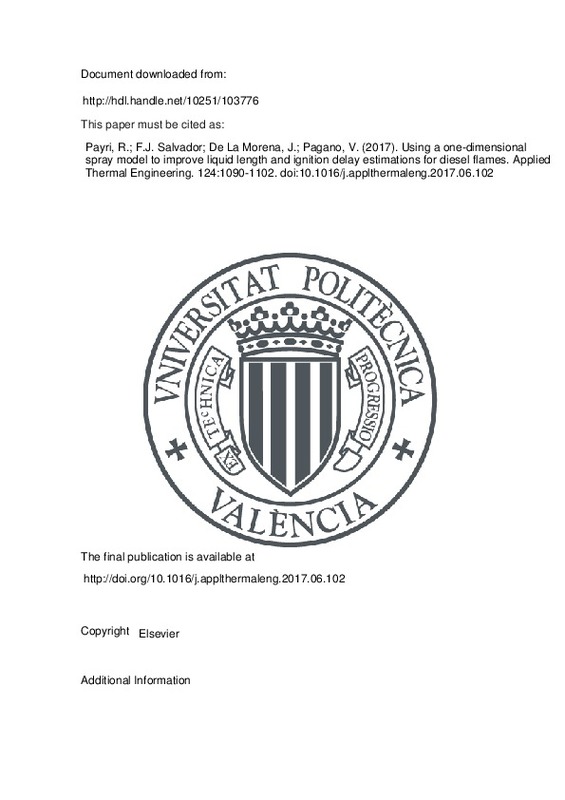JavaScript is disabled for your browser. Some features of this site may not work without it.
Buscar en RiuNet
Listar
Mi cuenta
Estadísticas
Ayuda RiuNet
Admin. UPV
Using a one-dimensional spray model to improve liquid length and ignition delay estimations for diesel flames
Mostrar el registro sencillo del ítem
Ficheros en el ítem
| dc.contributor.author | Payri, Raul
|
es_ES |
| dc.contributor.author | Salvador, F.J.
|
es_ES |
| dc.contributor.author | De La Morena, Joaquín
|
es_ES |
| dc.contributor.author | Pagano, Vincenzo
|
es_ES |
| dc.date.accessioned | 2018-06-11T04:26:02Z | |
| dc.date.available | 2018-06-11T04:26:02Z | |
| dc.date.issued | 2017 | es_ES |
| dc.identifier.issn | 1359-4311 | es_ES |
| dc.identifier.uri | http://hdl.handle.net/10251/103776 | |
| dc.description.abstract | [EN] In the current paper, a methodology based on the combination of a one-dimensional spray model and experimental correlations has been proposed to predict the physical time associated with ignition delay in diesel diffusion flames. This physical time depends significantly on the nozzle geometry, and its influence is not captured in traditional Arrhenius-like correlation. To assess this influence, three multi-hole nozzles with different degrees of conicity (expressed in terms of k-factor) have been tested onan optically accessible 2-stroke single-cylinder engine. First, the hydraulic behavior of the nozzles is assessed from the point of view of injection rate and spray momentum. Later, the effect of the geometry on vapor spray angle has been analyzed through a Schlieren visualization technique. Mie-scattering has allowed to determine the stabilized liquid length. Then, chemiluminescence imaging was used to obtain the temporal and spatial appearance of OH radicals, which are used as indicators to the ignition delay. Finally, all the results are combined with a one-dimensional spray model to determine the physical induction time and include it into a new ignition delay correlation, which shows up to 4% accuracy improvement compared to a traditional Arrhenius equation. (C) 2017 Elsevier Ltd. All rights reserved. | es_ES |
| dc.description.sponsorship | This work was partly sponsored by "Ministerio de Economia y Competitividad", of the Spanish Government, in the frame of the Project "Estudio de la interaccion chorro-pared en condiciones realistas de motor", Reference TRA2015-67679-c2-1-R. | |
| dc.language | Inglés | es_ES |
| dc.publisher | Elsevier | es_ES |
| dc.relation.ispartof | Applied Thermal Engineering | es_ES |
| dc.rights | Reconocimiento - No comercial - Sin obra derivada (by-nc-nd) | es_ES |
| dc.subject | Diesel | es_ES |
| dc.subject | Nozzle geometry | es_ES |
| dc.subject | Ignition delay | es_ES |
| dc.subject | 1D model | es_ES |
| dc.subject.classification | MAQUINAS Y MOTORES TERMICOS | es_ES |
| dc.title | Using a one-dimensional spray model to improve liquid length and ignition delay estimations for diesel flames | es_ES |
| dc.type | Artículo | es_ES |
| dc.identifier.doi | 10.1016/j.applthermaleng.2017.06.102 | es_ES |
| dc.relation.projectID | info:eu-repo/grantAgreement/MINECO//TRA2015-67679-C2-1-R/ES/ESTUDIO DE LA INTERACCION CHORRO-PARED EN CONDICIONES REALISTAS DE MOTOR/ | es_ES |
| dc.rights.accessRights | Abierto | es_ES |
| dc.date.embargoEndDate | 2019-09-01 | es_ES |
| dc.contributor.affiliation | Universitat Politècnica de València. Departamento de Máquinas y Motores Térmicos - Departament de Màquines i Motors Tèrmics | es_ES |
| dc.description.bibliographicCitation | Payri, R.; Salvador, F.; De La Morena, J.; Pagano, V. (2017). Using a one-dimensional spray model to improve liquid length and ignition delay estimations for diesel flames. Applied Thermal Engineering. 124:1090-1102. https://doi.org/10.1016/j.applthermaleng.2017.06.102 | es_ES |
| dc.description.accrualMethod | S | es_ES |
| dc.relation.publisherversion | http://doi.org/10.1016/j.applthermaleng.2017.06.102 | es_ES |
| dc.description.upvformatpinicio | 1090 | es_ES |
| dc.description.upvformatpfin | 1102 | es_ES |
| dc.type.version | info:eu-repo/semantics/publishedVersion | es_ES |
| dc.description.volume | 124 | es_ES |
| dc.relation.pasarela | S\339935 | es_ES |
| dc.contributor.funder | Ministerio de Economía, Industria y Competitividad | es_ES |







![[Cerrado]](/themes/UPV/images/candado.png)

